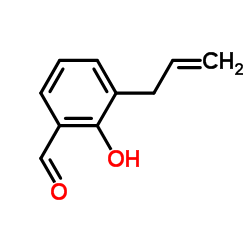315183-21-2
| Name | 4-(Phenylmethyl)-1-piperazineaceticacid[[2-hydroxy-3-(2-propenyl)phenyl]methylene]hydrazide |
|---|---|
| Synonyms |
1-Piperazineacetic acid, 4-(phenylmethyl)-, 2-[(1Z)-[2-hydroxy-3-(2-propen-1-yl)phenyl]methylene]hydrazide
N'-[(Z)-(3-Allyl-2-hydroxyphenyl)methylene]-2-(4-benzyl-1-piperazinyl)acetohydrazide (4-Benzylpiperazino)acetic acid (3-allyl-2-hyroxybenzylidene)hydrazide 1-Piperazineacetic acid PAC-1 N'-[(Z)-(3-Allyl-2-hydroxyphenyl)methylene]-2-(4-benzylpiperazin-1-yl)acetohydrazide PAC1 PAC-1,PAC1 (E)-N'-(3-allyl-2-hydroxybenzylidene)-2-(4-benzylpiperazin-1-yl)acetohydrazide PAC 1 |
| Description | PAC-1 is an activator of procaspase-3 induces apoptosis in cancer cells with EC50 of 2.08 μM. |
|---|---|
| Related Catalog | |
| Target |
Procaspase-3:2.08 μM (EC50) |
| In Vitro | PAC-1 activates procaspase-3 with an EC50 of 2.08 μM. PAC-1 exhibits an enhanced zinc chelating ability (EC50= 7.08 μM). PAC-1 induces leukemia cell death with IC50 of 4.03 μM, which is consistent with the values reported by other investigators. PAC-1 treatment also results in death of other malignant cells in a concentration-dependent manner with IC50s ranging from 4.03 to 53.44μM. The overall mean IC50 in the fifteen malignant cell lines is 0.88 mM for WF-210 and 19.40 μM for PAC-1. In contrast, the sensitivity of the normal human cells (PBL, L-02, HUVEC and MCF 10A) to WF-210 is 2.6-fold lower (mean IC50=412.34 μM) than PAC-1 (mean IC50=158.29 μM)[1]. Procaspase-activating compound-1 (PAC-1) is the first direct caspase-activating compound discovered. PAC-1 treatment upregulates Ero1α in multiple cell lines, whereas silencing of Ero1α significantly inhibits calcium release from ER and cell death[2]. |
| In Vivo | To evaluate the in vivo effect of WF-210 on the growth of malignant tumors, we examined the ability of WF-210 to suppress tumor growth in mouse Hep3B and MDA-MB-435 xenograft models. These two cell lines express procaspase-3 at relatively high levels. Tumors induced by xenografts of the liver cancer cell Hep3B are allowed to develop and grow to a size of 100 mm3, after which WF-210 (2.5 mg/kg) or PAC-1 (5.0 mg/kg) is given daily for two weeks by intravenous (i.v.) administration. As shown in both PAC-1 and WF-210 significantly inhibits the growth of Hep3B tumor xenografts[1]. |
| Kinase Assay | Various concentrations of WF-210 or PAC-1 are added to procaspase-3 in buffer containing 50 mM HEPES, 0.1% CHAPS, 10% glycerol, 100 mM NaCl, 0.1 mM EDTA, 10 mM DTT pH 7.4,and incubated for 12 h at 37°C. The final volume is 10 mL and the final concentration of procaspase-3 is 1 mM. Then 40 mL of the substrate Ac-DEVD-pNA (final concentration 0.4 mM) in buffer containing 50 mM HEPES pH 7.4, 100 mM NaCl, 10 mM DTT, 0.1 mM EDTA disodium salt, 0.10% CHAPS, 10% glycerol is added and the absorbance of the plate is read at 405 nm for a total of 1 h. The slope of the linear portion for each well is determined as the enzyme activity[1]. |
| Cell Assay | Cell viability is measured using the MTT method or the Cell Titer-Glo luminescent assay. For the MTT assay, the cells (1×105 cells/mL) are seeded into 96- well culture plates. After overnight incubation, cells are treated with various concentrations of agents (PAC-1, WF-210 or other agents) for 24 or 72 h. Then 10 mL MTT solution (2.5 mg/mL in PBS) is added to each well, and the plates are incubated for an additional 4 h at 37°C. After centrifugation (2500 rpm, 10min), the medium containing MTT is aspirated, and100mL DMSO is added. The optical density of each well is measured at 570 nm with a Biotek Synergy HT Reader. The Cell Titer-Glo kit is used to determine the relative levels of intracellular ATP as a biomarker for live cells[1]. |
| Animal Admin | Mice[1] To determine the in vivo anti-tumor activity of WF-210, viable human gallbladder cancer GBC-SD cells (5×106/100 mL PBS per mouse), human breast cancer MDA-MB-435 cells (1×107/100 mL PBS per mouse), human liver cancer Hep3B cells (5×106/100 mL PBS per mouse) and human breast cancer MCF-7 cells (1×107/100 mL PBS per mouse) are subcutaneously (s.c.) injected into the right flank of 7- to 8-week old male SCID mice or Balb/c nude mice. Cell numbers are confirmed by trypan blue staining prior to injection. Specially, MCF-7 xenograft mice are also administered with the hormone 17-beta-estradiol (3 mg/kg) on alternate days. When the average s.c. tumor volume reached 100 mm3, mice are randomly divided into various treatment and control groups (eight mice per group). Tumor size is measured once every two days with a caliper (calculated volume=shortest diameter2×longest diameter/2). Body weight, diet consumption and tumor size are recorded once every two days. After two or four weeks, mice are sacrificed and tumors are excised and stored at -80°C until further analysis. |
| References |
| Density | 1.1±0.1 g/cm3 |
|---|---|
| Molecular Formula | C23H28N4O2 |
| Molecular Weight | 392.494 |
| Exact Mass | 392.221222 |
| PSA | 68.17000 |
| LogP | 4.26 |
| Appearance | white |
| Index of Refraction | 1.597 |
| Storage condition | Store at +4°C |
| Water Solubility | DMSO: ≥10mg/mL |
| Symbol |


GHS07, GHS09 |
|---|---|
| Signal Word | Warning |
| Hazard Statements | H302-H315-H319-H335-H400 |
| Precautionary Statements | P261-P273-P305 + P351 + P338 |
| Personal Protective Equipment | dust mask type N95 (US);Eyeshields;Gloves |
| Hazard Codes | Xn,N |
| Risk Phrases | 22-36/37/38-50/53 |
| Safety Phrases | 26-36/37-60-61 |
| RIDADR | UN 3077 |
| Precursor 2 | |
|---|---|
| DownStream 0 | |


